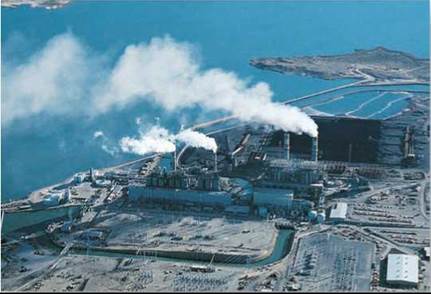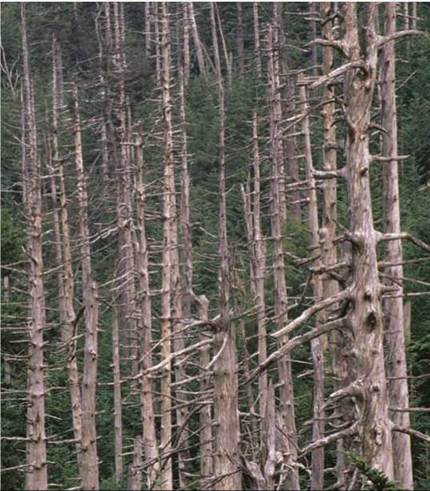THE LIVING WORLD
Unit Eight. The Living Environment
38. Human Influences on the Living World
The smokestacks you see in figure 38.2 are those of the Four Corners power plant in New Mexico. This facility burns coal, sending the smoke high into the atmosphere through these tall stacks. The smoke contains high concentrations of sulfur dioxide and other sulfates, which produce acid when they combine with water vapor in the air. The first tall stacks were introduced in Britain in the mid-1950s, and the design rapidly spread through Europe and the United States. The intent of having tall smokestacks was to release the sulfur-rich smoke high in the atmosphere, where winds would disperse and dilute it, carrying the acids far away.

Figure 38.2. Tall stacks export pollution.
Tall stacks like those of the Four Comers coal-burning power plant in New Mexico send pollution far up into the atmosphere.
However, in the 1970s, scientists began noticing that the acids from the sulfur-rich smoke were having devastating effects. Throughout northern Europe, lakes were reported to have suffered drastic drops in biodiversity, some even becoming devoid of life. The trees of the great Black Forest of Germany seemed to be dying—and the damage was not limited to Europe. In the eastern United States and Canada, many of the forests and lakes have been seriously damaged.
It turns out that when the sulfur introduced into the upper atmosphere combined with water vapor to produce sulfuric acid, the acid was taken far from its source, but it later fell along with water as acidic rain and snow. This pollution-acidified precipitation is called acid rain (but the term acid precipitation is actually more correct). Natural rainwater rarely has a pH lower than 5.6; however, rain and snow in many areas of the United States have pH values less than 5.3, and in the northeastern U.S., pHs of 4.2 or below have been recorded, with occasional storms as low as 3.0.
Acid precipitation destroys life. Many of the forests of the northeastern United States and Canada have been seriously damaged. In fact, it is now estimated that at least 1.4 million acres of forests in the Northern Hemisphere have been adversely affected by acid precipitation (figure 38.3). In addition, thousands of lakes in Sweden and Norway no longer support fish—these lakes are now eerily clear. In the northeastern United States and Canada, tens of thousands of lakes are dying biologically as their pH levels fall to below 5.0. At pH levels below 5.0, many fish species and other aquatic animals die, unable to reproduce.

Figure 38.3. Acid precipitation.
Acid precipitation is killing many of the trees in North American and European forests. Much of the damage is done to the mycorrhizae, fungi growing within the cells of the tree roots. Trees need mycorrhizae in order to extract nutrients from the soil.
The solution seems like it would be easy—clean up the sulfur emissions. But there have been serious problems with implementing this solution. First, it is expensive. Estimates of the cost of installing and maintaining the necessary “scrubbers” in the United States are on the order of $5 billion a year. An additional difficulty is that the polluter and the recipient of the pollution are far from one another, and neither wants to pay so much for what they view as someone else’s problem. Clean Air legislation has begun to address this problem by mandating some cleaning of emissions in the United States, although much still remains to be done worldwide.
Key Learning Outcome 38.2. Pollution-acidified precipitation—loosely called acid rain—is destroying forest and lake ecosystems in Europe and North America. The solution is to clean up the emissions.